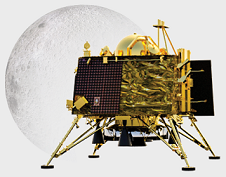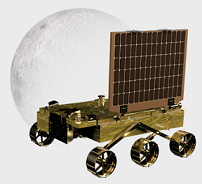 Introduction
Introduction
Chandrayaan 2 Mission 2019, India’s second lunar mission, has three Modules Namely Orbiter, Lander (Vikram) and Rover (Pragyan). The Orbiter and Lander Modules will be interfaced mechanically and stacked together as an integrated module and accommodated inside the GSLV MK-III Launch Vehicle. The Rover is housed inside the Lander.
The Primary Objective of Chandrayaan 2 Misson 2019 is to demonstrate the ability to Soft-Land on the Lunar Surface and Operate a Robotic Rover on the surface. Scientific goals include studies of Lunar Topography, Mineralogy, Elemental Abundance, the Lunar Exosphere, and Signatures of Hydroxyl and Water Ice.
India’s Geosynchronous Satellite Launch Vehicle, GSLV MkIII-M1 Successfully launched Chandrayaan-2 Spacecraft at 2:43 p.m. IST on July 22, 2019, into its Planned Orbit with a Perigee (Nearest Point to Earth) of 169.7 km and an Apogee (Farthest Point to Earth) of 45475 Km. The launch took place from the Second Launch Pad at Satish Dhawan Space Centre SHAR, Sriharikota.
 History
History
- On 12 November 2007, representatives of the Russian Federal Space Agency (Roscosmos) and ISRO signed an agreement for the two agencies to work together on the Chandrayaan-2 project.
- The Indian government approved the mission in a meeting of the Union Cabinet, held on 18 September 2008 and chaired by Prime Minister Manmohan Singh.
- The design of the spacecraft was completed in August 2009, with scientists of both countries conducting a joint review.
- Although ISRO finalized the payload for Chandrayaan 2 per schedule, the mission was postponed in January 2013 and rescheduled to 2016 because Russia was unable to develop the lander on time.
- Since the technical aspects connected with the Phobos-Grunt mission were also used in the lunar projects, which needed to be reviewed.
- When Russia cited its inability to provide the lander even by 2015, India decided to develop the lunar mission independently.
 Orbiter
Orbiter
Orbiter:
Source:Click Here
 Lander
Lander
Lander — Vikram:
Source:Click Here
 Rover
Rover
Rover — Pragyan:
Source:Click Here
 Mission
Mission
- Isro will investigate key data to find out why communication was lost with the Vikram lander.
- The scientists will also use Chandrayaan-2's orbiter to map the area for clues and to establish if there were any performance divergences.
- While India's second moon mission has been majorly successful, the scheduled soft-landing on the moon could not be achieved.
- Chandrayaan-2 lander which failed to land made up only 5% of mission
- 95% of the mission will be carried out by orbiter which is successfully in its place
- Orbiter can take pictures of moon and send them to Isro
- Isro lost contact with Chandrayaan-2 lander 2.1 kms above lunar surface
- The Chandrayaan-2 orbiter is safe and is revolving around the Moon
- Isro is analyzing data to figure out what happened with the lander
- The Indian Space Research Organisation's '15 minutes of terror' were about to come to a euphoric end. Or, so it seemed.
- The setting was Isro's Mission Operations Complex in Bengaluru that is tracking the progress of Chandrayaan-2, India's second mission to the Moon.
- And the occasion was the landing of Vikram and Pragyaan, the Chandrayaan-2 lander and rover.
- The landing was to make India the only country in the world to land a rover near the south pole of the Moon.
Why are we going to the Moon?
The Moon is the closest cosmic body at which space discovery can be attempted and documented. It is also a promising testbed to demonstrate the technologies required for deep-space missions. Chandrayaan 2 attempts to foster a new age of discovery, increase our understanding of space, stimulate the advancement of technology, promote global alliances, and inspire a future generation of explorers and scientists.
What are the scientific objectives of Chandrayaan 2?
Moon provides the best linkage to Earth’s early history. It offers an undisturbed historical record of the inner Solar system environment. Though there are a few mature models, the origin of the Moon still needs further explanations. Extensive mapping of the lunar surface to study variations in lunar surface composition is essential to trace back the origin and evolution of the Moon.
Why explore the Lunar South Pole?
The lunar South Pole is especially interesting because of the lunar surface area here that remains in shadow is much larger than that at the North Pole. There is a possibility of the presence of water in permanently shadowed areas around it.
What makes Chandrayaan 2 special?
1st space mission to conduct a soft landing on the Moon's south polar region, 1st Indian expedition to attempt a soft landing on the lunar surface with home-grown technology, 1st Indian mission to explore the lunar terrain with home-grown technology, 4th country ever to soft-land on the lunar surface
Chandrayaan - 2 Lander goes silent. What Now?
Isro has a number of data sets to go over those sent back by Vikram before it went incommunicado as well as those possibly captured by various Earth-based space communications devices. Isro is also making constant attempts to re-establish communication with the Vikram lander.
So, has Chandrayaan - Failed?
Not at all. Landing a rover on the Moon was just one no matter how ambitious part of the Chandrayaan-2 mission. In fact, the lander Vikram and rover Pragyaan combined carried a lesser number of experiments (five) than the Chandrayaan-2 orbiter, which has onboard eight scientific payloads.
What's Next For ISRO?
Indian Space Research Organisation will be tied up in investigating what happened to the Chandrayaan-2 lander during its descent on to the lunar surface.
But the space agency will also soon get busy with equally ambitious missions and projects it has lined up. These include sending a probe to the Sun, preparing for the second Mars orbiter mission, exploring the possibility of a sending a spacecraft to Venus.
The most ambitious of these missions, and the most ambitious space mission in India's history is the Gaganyaan mission under which Isro will send three Indians to space on an Indian spacecraft. The Gaganyaan mission is a tie-up between Isro and Indian military the latter will select and train crewpersons for the mission (a process that has already begun).
ISRO mentions 6 objectives the Chandrayaan 2 mission aims at achieving. They are as follows:
- Push the boundaries of scientific knowledge to unravel the mysteries of this universe.
- Unleash innovation by throwing challenges at the youth of the country, and spurring future research and development.
- Explore economic possibilities by strengthening ISRO’s alliance with the industry.
- Engaging with the general public by motivating the youth to undertake real-life applications of science and technology.
- Expanding India’s footprint in space as Moon is the perfect test-bed for proving technologies required for future space explorations.
- Making India a key contributor to exploring and uncovering secrets of the universe, thus fostering shared aspirations of the international community.
- India will be the first country to land on the southern pole of the moon.
- This would give ISRO opportunity to name that site on the moon. 2. Indigenous mission: 13 instruments from India, one instrument from US space agency, NASA. 3. Future Space Exploration: mission will also expand the country’s footprint in space as a moon is the perfect test-bed for proving technologies required for future space exploration.
- Trajectory accuracy: Ensuring trajectory accuracy while navigating 3.844 lakh km has its own challenges.
Communication hurdle: Owing to the large distance from Earth, radio signals, which need to be picked up, would be weak.
Lunar dust: Firing engines close to the lunar surface results in the backward flow of gases and dust, causing hindrance to deployment mechanism and damaging sensors.
Extreme temperatures: A lunar day or night lasts 14 earth days, resulting in extreme surface temperature.
Trans-lunar injection, capture: series of engine burns to get close to the moon, intersection of probe and moon must be predicted in advance with accuracy.
Orbiting: The lumpy lunar gravity influences the orbit of the spacecraft.
- A mission update of the Indian Space Research Organisation (ISRO) has said that Chandrayaan 2 which is planned to be launched during July 9-16, will have 14 Indian payloads or study devices.
- Chandrayaan-2, India’s second mission to the moon is a totally indigenous mission.
- It comprises of an Orbiter, Lander named ‘Vikram’ and Rover named ‘Pragyan’.
- The orbiter will circle the moon and provide information about its surface, while the lender will make a soft landing on the surface and send out the rover.
- The rover will be used mostly for in situ experiments.
- Chandrayaan-2 will launch aboard a Geosynchronous Satellite Launch Vehicle Mark III, (GSLV -MK III) rocket.
- The GSLV-Mk III is a three-stage heavy-lift launch vehicle that has been designed to carry four-tonne class satellites into Geosynchronous Transfer Orbit (GTO).
- In October 2008, ISRO had launched its orbiter mission Chandrayaan-1 on its PSLV booster. The spacecraft had 11 payloads.
- One of the U.S. payloads shares credit with Chandrayaan-1 for confirming the presence of water ice on the moon.
- Before that, the Moon Impacter Probe carrying the Indian tricolor image was made to hard-land on the lunar south pole.






